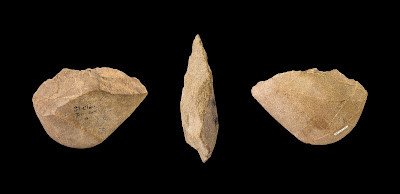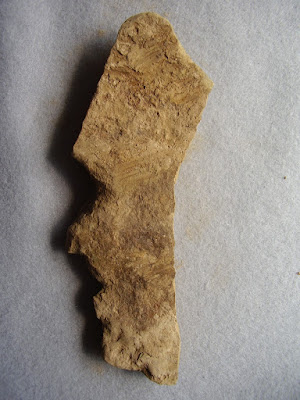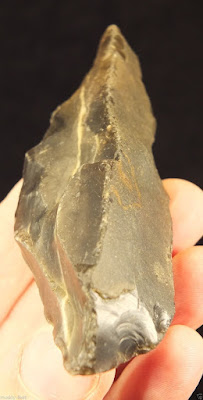"The Hopewell Shaman" Licking County, Ohio
About 2,000 years old
About 2,000 years old
The Hopewell Shaman recovered at the Newark Earthworks in 1881 just 10 miles from my home is particularly not what most Native American portable rock art looks like based on my own observations. And most Native American tools are not flaked chert or flint tools, but coarse stone ones in expedient, crude and opportunistic forms.
American archaeology was born in 1784 when Thomas Jefferson split open an earthen mound on his Monticello estate. In 2011 when I requested a meeting with Ohio's curating archaeologist to show him a suspected Paleolithic flint sculpture hoard I found on the shore of a former glacial terminus lake, he replied with a "no thanks" and sent some photos of some stone figures found in Ohio mounds, including the above Wray figurine, and explaining "this is what Native American art looks like." 227 years and so much for progress in Archaeology. They truly are "mound-bound" in their thinking.
The Ohio amateur archaeologist community has not developed a strong Paleolithic interest other than "fluted points." The book "Ohio Stone Tools" goes wrong starting with "A" for "anvil" which is incredulously missing from this publication and its decades later updated version. I have found anvils to be one the most common artifacts, often visible on the landscape and a proxy for Stone Age culture sites. They often have stories to tell based on their use scars. Anvils can also indicate bi-polar lithic reduction sites which produce distinct artifact types often not recognized by North Americans.
Paleolithic studies in North America seem unnecessarily limited to flints and cherts and tend to focus on spear points and the Clovis tool kit and its immediate precursors.
There is a great number and diversity of coarse stone expedient and opportunistic tools which may be found in surface surveys which seem to have simply been forsaken in the quest for more easily recognized, categorized, formalized and, most tragically, monetized types. The Appalachian and Allegheny mountain creek valleys in the eastern United States are chock full of these types of materials with the absence of flaked flint tools or debitage. No one has systemically studied them as far as I am able to determine without having access to academic journals behind "paywalls."
The sheer volume of this archaeological material suggests the presence of many people over long periods of time generating likely many billions of crude stone artifacts. Farmers, landowners and amateur archaeologists have tried to call attention to anomalous crude tools and have been summarily dismissed by Archaeology because of a kind of endemic Americentrism still rooted in Jefferson's mound which has severely distorted its knowledge generation system. There is a misconception that Mode-I Oldowan style and other simple pebble tools ceased being made in the Old World in the Lower Paleolithic and are not found in the Americas. This is a fallacy and is wide open for research by avant-garde archaeology scholars.
With humans in dense numbers in Asia by 900,000 years ago, and all kinds of flora and fauna crossing the Bearing land bridge, it seems highly unlikely the Americas remained sterile of humans until 15,000 to 20,000 years ago.
There could have been early people living in North America who did not use flaked cherts and flints but favored other more easily available materials on the landscape modified using techniques they were familiar with. Migrants from East Asia may have been just so disposed:
Stone with good fracture qualities—such as flint, jasper, and chert—was not always as readily available in Asia as it was elsewhere in the world. Asian populations, therefore, depended on coarse-grained quartz, volcanic tuff, and petrified wood, none of which lends itself to fine tool fabrication. The lack of good material may explain why stone tool making did not evolve in Asia. Choppers and chopping tools were still being made, for example, by Solo man of Asia, while his European contemporary, Neanderthal man, was able to manufacture hand axes, borers, and knives, as well as choppers.The Clovis fetish gave them a wild goose chase for a few decades. As long as North American Archaeology is chasing flaked chert and flint to the near exclusion of other stone materials, it still may not be chasing evidence for the earliest Americans, but its own tail.
Britannica
These rocks were recovered together eroding out of a hilltop in eastern Licking County, Ohio, which in the Ice Age was not glaciated but is described by local geologists as a "glacial overlook." It was a promontory site where one could have stood on the hill and observed the flowing Wisconsin and Illinoisan glaciers' terminal moraines in the valley below during their respective eras. The valley was at one time 400 feet lower than its present day 100 feet when it was a part of the Plio-Pleistocene Teays River system. It has been filled with glacial till in the past two episodes.
Each of these 10 items from the glacial overlook were identified by me as artifacts and collected as representative of tools available in great numbers in the local area and at places identified by many amateur archaeologists as reported to this blog. They came from within a one meter area but demonstrate 5 distinct lithic reduction strategies or technologies which are not recognized by many archaeologists because of the focus on flint. I only collected 10 tools and was not conscious of the reduction types until inspecting the group on my workbench. Portable rock art featured on this blog has been found nearby but not in direct association with these particular tools.
1,2 From once rounded pebbles subject to bi-polar fracturing using a hammer and an anvil most likely anchored in the ground. The result is a "wedge" like an orange slice which has the smoothness of the cortex behind a sharp edge. On 2 above, the almost horizontal surface of the lower part is a result of use wear while the other visible planes are flake surfaces. The distal tip has become single-notched through use wear.
3,4 Mode I-Oldowan style pebble tools with just one break to create a sharp edge and showing use wear.
5,6 Naturally ergonomic hard stones which may have light work to make "distressed grip pads" and which demonstrate quite significant surface wear from use. Only slight modification to overall natural shape. 5 seems to be of pink granite and 6 seems a translucent to smokey grey quartzite.
7,8 White quartzite which had been flaked from larger pieces and which both show evidence of use. Number 7 has been reduced to a shape resembling a piece of chalk in its final seconds of use. 7 and 8 are so similar it seems possible they came from the parent core stone.
9,10 Heavy duty rhomboidal hand tools. They can be burins, borers, pounders, grinders, choppers and scrapers. They are made by sandwiching tabular stone blanks between two buffers, wood or stone slabs, and chipping the stone that is "sticking out the vise." This kind of diamond shape is an ergonomic form which conforms to the demands of the hand during use. They often have a notch to accommodate the thumb along one of edges and number 10 above shows just such a notch. These two are particularly thick or "chunky." They too demonstrate use wear. I first described this novel tool form in 2012 and their potential importance to American Archaeology, and frequent association with what has been identified as portable rock art, should not be underestimated. Illustration follows below.
Illustration of 9 and 10
Number 10 in my hand
Side 2 perspective of the Licking County, Ohio, non-cryptocrystalline pebble tool artifacts: they are made of basalt, sandstone, quartzite and granite
One million to 300,000 years old chopper, Terrasse 60m, Saint-Clar-de-Rivière, Haute Garonne, France. Former collection of Henri Breuil. The simple "Oldowan" style chopper was in use in the Acheulean which demonstrates how it is dangerous to assign a tool a time period, or a human species for that matter, based on its morphology. Due to their simplicity and expediency it seems possible then that Native Americans could have been making these kinds of tools into the Holocene. The long-running assumption that Mode I type simple tools can't be in America because people were not in America during the "Oldowan period" is not valid.
Who was making and using these tools in North America and when were they here? In its current state, the field of Archaeology may not be in a position to answer a question like this.
Art from the Licking County, Ohio, glacial overlook featured earlier on this blog. A human face left profile sharing a mammoth head cresting its forehead. Ken Johnston find and interpretation.
This sculpture was found just 3 miles from the Hopewell Complex Newark Shaman find location. Is it just coincidence they both depict humans with animal heads atop their heads? Does this sculpture depict a human/mammoth shamanic transformation process in a way similar to the proposed Newark Shaman's human/bear transformation depiction? (click photo to expand)
Who was making this art and when were they here?
Art from the Licking County, Ohio, glacial overlook featured earlier on this blog. A human face left profile sharing a mammoth head cresting its forehead. Ken Johnston find and interpretation.
This sculpture was found just 3 miles from the Hopewell Complex Newark Shaman find location. Is it just coincidence they both depict humans with animal heads atop their heads? Does this sculpture depict a human/mammoth shamanic transformation process in a way similar to the proposed Newark Shaman's human/bear transformation depiction? (click photo to expand)
Who was making this art and when were they here?

















































